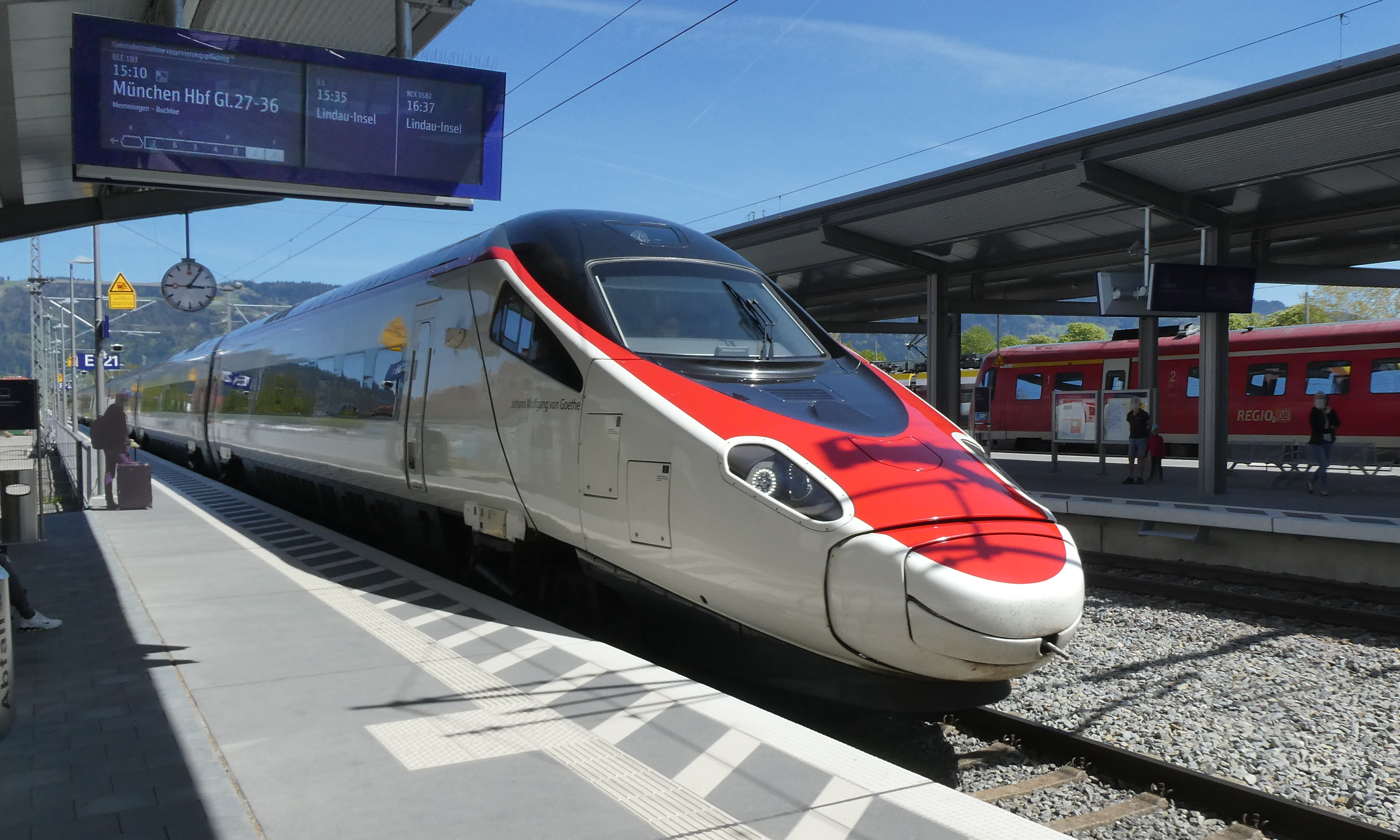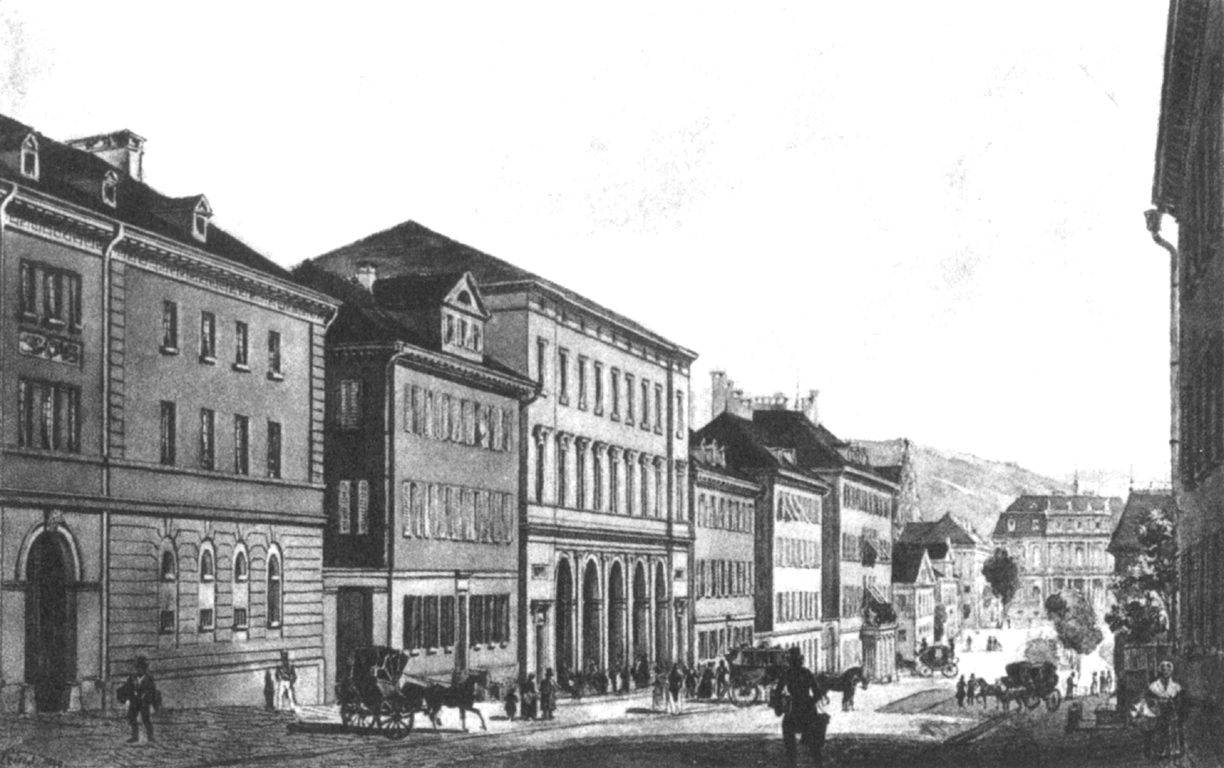|
Göppingen Station
Göppingen station is a station in the town of Göppingen in the German state of Baden-Württemberg. It is a transit station and is situated km 42.1 from Stuttgart on the Fils Valley Railway, which was completed in 1850 from Stuttgart to Ulm. Location The station is located on the southern edge of the inner city of Göppingen. To its east are large marshalling and freight yards, which are still used occasionally. To its west is a smaller disused freight yard with loading docks and the central bus station. Station layout The station consists of an entrance building, which houses a restaurant, two kiosks, a bakery, a bookstore and a travel centre. The former baggage and express freight facility is not used anymore. It has seven platform tracks, tracks 1 to 7. Only tracks 4 and 6 are regularly used for passenger trains. Only a few regional trains run on tracks 1 and 3. Platform track 5 is used once a day by a City Night Line train from Paris, continuing to Munich. Track 1 w ... [...More Info...] [...Related Items...] OR: [Wikipedia] [Google] [Baidu] |
Göppingen
Göppingen ( Swabian: ''Geppenge'' or ''Gebbenga'') is a town in southern Germany, part of the Stuttgart Region of Baden-Württemberg. It is the capital of the district Göppingen. Göppingen is home to the toy company Märklin, and it is the birthplace of football player Jürgen Klinsmann. It also hosts the headquarters of TeamViewer AG - the main sponsors of Manchester United. Geography Göppingen is situated at the bottom of the Hohenstaufen mountain, in the valley of the river Fils. The districts of Göppingen are Bartenbach, Bezgenriet, Faurndau, Göppingen, Hohenstaufen, Holzheim, Jebenhausen and Maitis. History Tradition holds that the city was founded by an Alemannic leader called Geppo sometime in the 3rd or 4th century. A disastrous fire on August 25, 1782 destroyed most of the town, but it was immediately rebuilt. Industrialisation during the 19th century made the area into a centre of industry. The importance of such industry is still seen in the town in the pres ... [...More Info...] [...Related Items...] OR: [Wikipedia] [Google] [Baidu] |
Cologne Central Station
Cologne ( ; german: Köln ; ksh, Kölle ) is the largest city of the German western state of North Rhine-Westphalia (NRW) and the fourth-most populous city of Germany with 1.1 million inhabitants in the city proper and 3.6 million people in the urban region. Centered on the left (west) bank of the Rhine, Cologne is about southeast of NRW's state capital Düsseldorf and northwest of Bonn, the former capital of West Germany. The city's medieval Catholic Cologne Cathedral (), the third-tallest church and tallest cathedral in the world, constructed to house the Shrine of the Three Kings, is a globally recognized landmark and one of the most visited sights and pilgrimage destinations in Europe. The cityscape is further shaped by the Twelve Romanesque churches of Cologne, and Cologne is famous for Eau de Cologne, that has been produced in the city since 1709, and "cologne" has since come to be a generic term. Cologne was founded and established in Germanic Ubii terri ... [...More Info...] [...Related Items...] OR: [Wikipedia] [Google] [Baidu] |
Plochingen Station
Plochingen station is the only station in the town of Plochingen in the German state of Baden-Württemberg and the most important railway junction of the Esslingen district. It is located 22.8 kilometres from Stuttgart Hauptbahnhof on the Fils Valley Railway and at the beginning of the Neckar-Alb Railway. History In the planning of the Fils Valley Railway (german: Filstalbahn) from Stuttgart to Ulm the chief engineer Michael Knoll foresaw a station southeast of Plochingen. At that time, approximately 1,900 people lived in the market town and its vineyards. On 14 December 1846, the Royal Württemberg State Railways (Königlich Württembergische Staats-Eisenbahnen) officially opened the Esslingen–Plochingen line. The completion of the next section to Süßen took place on 11 October 1847. The first station building, which no longer exists, was a two-storey sandstone building. In 1852, a second track was completed on the Fils Valley line from Cannstatt to Plochingen. On 20 Septe ... [...More Info...] [...Related Items...] OR: [Wikipedia] [Google] [Baidu] |
Regional-Express
In Germany, Luxembourg and Austria, the Regional-Express (RE, or in Austria: REX) is a type of regional train. It is similar to a semi-fast train, with average speed at about 70–90 km/h (top speed often 160 km/h) as it calls at fewer stations than '' Regionalbahn'' or S-Bahn trains, but stops more often than ''InterCity'' services. Operations The first Regional-Express services were operated by DB Regio, though since the liberalisation of the German rail market (''Bahnreform'') in the 1990s many operators have received franchise rights on lines from the federal states. Some private operators currently operate trains that are similar to a Regional-Express service, but have decided to use their own names for the sake of brand awareness instead. Regional-Express services are carried out with a variety of vehicles such as DMUs (of Class 612), EMUs (of Class 425 or 426) or, most commonly, electric or diesel locomotives with double-deck cars, the latter often with ... [...More Info...] [...Related Items...] OR: [Wikipedia] [Google] [Baidu] |
Innsbruck Hauptbahnhof
Innsbruck Hauptbahnhof (German for ''Innsbruck Main Station or'' ''Central Station'') is the main railway station in Innsbruck, the capital city of the Austrian federal state of Tyrol. Opened in 1853, the station is a major hub for western and central Austria. In 2019, it was the 8th-busiest station in the country, and the 2nd-busiest outside of Vienna after only Linz Hauptbahnhof, with 315 train movements and 38,500 passengers daily. The station is owned and operated by ÖBB. It forms the junction of the Arlberg Railway to Bregenz, Brenner Railway to Italy, Mittenwald Railway to Germany's region of Ällgau, Stubaitalbahn and the main east-west artery Lower Inn Valley Railway. Location Innsbruck Hauptbahnhof is located at Südtiroler Platz. It is at the southeastern side of the city centre and a 10-minute walk away. History The planning of a railway line in the region of Tyrol began in 1850 under the Austrian Empire. Three years later, Emperor Franz Joseph I approved the r ... [...More Info...] [...Related Items...] OR: [Wikipedia] [Google] [Baidu] |
Lindau-Reutin Station
Lindau-Reutin station is a junction station in the town of Lindau (Lake Constance), where the Aeschach curve branches off from the Lindau–Bludenz line. It is also a border station with Austria. In the course of the reconstruction of the Lindau rail hub, which began in 2016, the rail facilities, which were last used only as a goods station, were expanded into Lindau's new long-distance train station, which went into operation in 2020. In contrast to the terminus station Lindau-Insel (until 2020: Lindau Hbf), which opened in 1854, the station in the most populous district Reutin is a through station on the mainland. A station for local passenger services opened at Lindau-Reutin as ''Lindau-Lokalbahnhof'' in 1876 and was known as ''Lindau-Ost'' from 1911 but the last passenger services to it ended in 1980. The station building is located on Bregenzer Straße, on a level with Berliner Platz. Operations Since the timetable change on December 13, 2020, six connections are offere ... [...More Info...] [...Related Items...] OR: [Wikipedia] [Google] [Baidu] |
Ulm Hauptbahnhof
Ulm Hauptbahnhof is the main station in the city of Ulm, which lies on the Danube, on the border of the German states of Baden-Württemberg and Bavaria in the Danube-Iller region (''Region Donau-Iller''). Ulm Hauptbahnhof has twelve platforms, of which five are terminating platforms, and forms a major railway junction. Other stations in the city are Ulm-Söflingen to the west and Ulm Ost (east) to the east and Ulm-Donautal (Danube valley) in the industrial area. The Ulm marshalling yard is located to the west of the city. Neu-Ulm (New Ulm), which lies across the Danube in Bavaria, has the stations of Neu-Ulm, Finningerstraße and Gerlenhofen. Ulm is located on the railway line from Stuttgart to Munich, over which Intercity-Express trains operate, and part of the Magistrale for Europe (trunk line) from Paris to Budapest. European cities such as Amsterdam, Budapest, Paris and Linz can be reached without transfers. Every day, about 29,000 passengers use the station. It is used dail ... [...More Info...] [...Related Items...] OR: [Wikipedia] [Google] [Baidu] |
Stuttgart Hauptbahnhof
Stuttgart Hauptbahnhof (; en, Stuttgart central station) is the primary railway station in the city of Stuttgart, the state capital of Baden-Württemberg, in southwestern Germany. It is the largest regional and long-distance railway station in Stuttgart, the main node of the Stuttgart S-Bahn network, and, together with the station at Charlottenplatz, it is the main node of the Stuttgart Stadtbahn. Located at the northeastern end of the ''Königstraße'', the main pedestrian zone of the city centre, the main line station is a terminus, whilst the subterranean S-Bahn and Stadtbahn stations are through-stations. The station is well known for its 12-storey tower with a large, rotating and illuminated Mercedes-Benz star insignia on top; the tower and station building are city landmarks. Plans for the controversial Stuttgart 21 project to convert the main line terminus station into an underground through station include the demolition of the side wings of the building, together with ... [...More Info...] [...Related Items...] OR: [Wikipedia] [Google] [Baidu] |
Heidelberg Hauptbahnhof
Heidelberg Hauptbahnhof (commonly known as Heidelberg HBF) is the main railway station for the city of Heidelberg. In 2005 it was used by around 42,000 passengers per day and is one of the largest passenger stations in the German state of Baden-Württemberg. The station is classified by Deutsche Bahn as a category 2 station. The first station was built in 1840 as a terminus near the old town of Heidelberg. Urban problems as a result of the extension of part of the station to form a through station in 1862 and a lack of expansion options resulted in a decision the early 20th century to relocate the station as a new through station a kilometre to the west. Interrupted by two world wars, the relocation of the Heidelberg railway facilities took over 50 years. Inaugurated in 1955, the station is now considered to be "the most beautiful and architecturally interesting buildings of Deutsche Bundesbahn", and since 1972 it has been listed as a "cultural monument of special importance" unde ... [...More Info...] [...Related Items...] OR: [Wikipedia] [Google] [Baidu] |
Mannheim Hauptbahnhof
Mannheim Hauptbahnhof (German for ''Mannheim central station'') is a railway station in Mannheim in the German state of Baden-Württemberg. It is the second largest traffic hub in southwestern Germany after Stuttgart Hauptbahnhof, with 658 trains a day, including 238 long-distance trains. It is also a key station in the Rhine-Neckar S-Bahn. 100,000 passengers embark, disembark or transfer between trains at the station each day. The station was modernised in 2001. It is classified by Deutsche Bahn as a category 2 station. Layout The station is located on the southern edge of central Mannheim. In November 2001, the station was comprehensively redeveloped with a modern shopping and service centre. Travellers reach the platforms via escalators and lifts in the wings of the entrance hall, which lead to a northern and a southern subway under the tracks. The routes to the platforms have been upgraded to make them accessible for the disabled. Lifts, escalators and a direction system f ... [...More Info...] [...Related Items...] OR: [Wikipedia] [Google] [Baidu] |


_(2).jpg)





